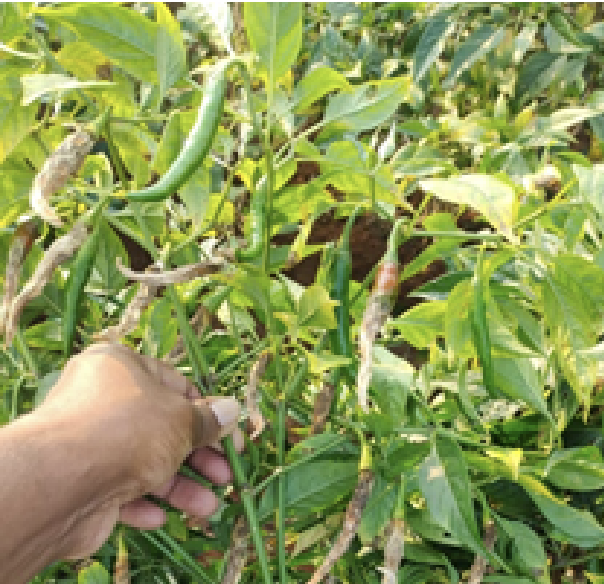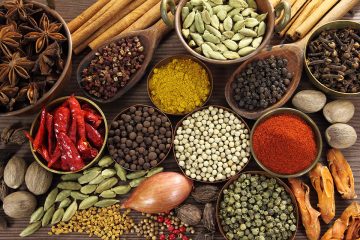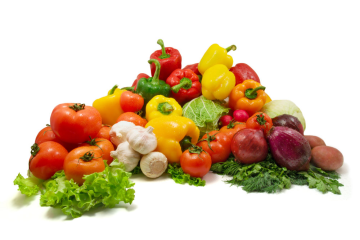Cloves – Cinnamon – Nutmeg
Indonesia
Indonesian spice exporters have been struggling lately due to low stocks, high costs and low profits and have little hope of recovering before the end of the 2021 season.
Due to increased uncertainty around market demand, as well as logistics challenges, Indonesia’s spice export industry is in a difficult situation. Buyers in the Europe and the USA are holding on to their unsold inventory in order to be ready for any future supply disruption issues.
In the current circumstances, exporters in many countries are facing financial difficulties and have little expectation of seeing their profit margins improve very soon. Many spice exporters in Indonesia have expressed pessimism as buyers from the United States and Europe hold off on purchasing key spices like clove, nutmeg, and cinnamon, which normally see an increase in trade volume during this time due to stock replenishment in preparation for winter and end-of-year festivities. However, most of the buyers in important destination nations (the United States, Germany, France, the Netherlands, and Eastern European countries) are delaying purchases due to two significant factors: market demand uncertainty and shipping logistics issues at destination ports.
Many buyers are opting for spot swaps (spot purchase) rather than 2022 season contracts. Traders that supply to processing plants in the EU are disproportionately affected by the current pandemic, which has resulted in low and unpredictable demand, as well as lower regional consumption. As a result, people are hesitant to get into long-term contracts or devote their financial resources. Importers are also acquiring goods from Vietnam, instead of Indonesia, at lower prices.
Exporters in Indonesia are also concerned on the supplies side, as shipping to key US ports such as Rotterdam and Hamburg remain costly and uncertain. Exporters with long-term contracts with importers on CFR terms are sharing horror stories of exorbitant freight charges eating into their profit margins. Some exporters have been fortunate enough to renegotiate with their customers and escape with a significant profit reduction. Others, on the other hand, have no choice but to default, risking a non-performance rating. Cinnamon bulk contracts headed for US ports from Indonesia face the most difficulties.
This issue regarding high freight costs can:
- Fuel speculative buying
- Negatively affect the price-to-quality ratio of products (For example, increased prices of 2nd grade items reduce the incentive for buyers to opt in for 1st grade choices)
- Alter the landscape of stakeholders at-source (i.e., farmers, manufacturers, processers), as exporters struggle to justify further funding to prepare raw materials for 2022 orders.
The current market condition is expected to endure until at least Q2 of next year, when buyers will need to restock their inventories. This will test the financial stability of exporters, as access to finances and capital to run their businesses remains limited and expensive. Major spice buyers on the other hand, who have been in this sector for
decades, if not centuries, can simply hold purchases and increase spot buying to sustain the current market problems.
Madagascar
Madagascar’s new clove harvest is already underway. This year’s harvest is better, and it will make up for the deficits in Indonesia and Sri Lanka.
Black Pepper
Vietnam & India
Black pepper prices this week stayed steady from the previous week, according to polls. Localities are currently trading between 81,000 and 83,500 VND/kg.
Gia Lai and Dong Nai provinces, in particular, maintained to have the lowest level of 81,000 VND/kg.
The two provinces of Dak Lak and Dak Nong have the same constant pricing of 82,000 VND/kg, which is higher than 1,000 VND/kg.
Similarly, the provinces of Binh Phuoc and Ba Ria-Vung Tau continued to purchase at 82,500 VND/kg and 83,500 VND/kg, respectively.
India has had to witness the illegal import of pepper from other countries as a result of the higher selling price in the local market, which is damaging to the interests of indigenous pepper growers.
The Chairman of India’s National Committee on Agriculture, Food Security, and Nutrition highlighted that the import of Sri Lankan pepper resulted in a significant price drop, warning against the current illicit pepper import. Both pepper growers in Kerala and Karnataka predict next year’s crop to be 45-50 percent lower than any previous crop, with an output of around 60,000 tonnes, according to projections for the 2022 crop.
Consumers are opting for ready-to-use pepper, which has resulted in a shift in household consumption habits. Interstate agents and pepper processing plants in India have thrived as a result of this.
Garlic
Argentina
The year 2021 has been a good one for Argentinian garlic growers and exporters. The country’s shipments of this vegetable were 10% higher in the first nine months of 2021 than in the same period last year. Strong domestic and international demand is driving an increase in exports and production, as individuals consume more garlic to improve their immune systems during these pandemic times. This has provided further incentives for the increase of garlic land in Argentina’s primary growing region, Mendoza, which is known as the country’s “garlic treasury,”
accounting for 88 percent of total output. The Garlic Integration and Development Fund, established in 2020, is actively promoting garlic production and exports in the stated province.
Argentina, behind China and Spain, is the world’s third-largest exporter of this garlic. Argentina’s garlic production has significantly increased since 2015, in response to continuously increasing worldwide demand. This circumstance has provided excellent opportunity for Mendoza garlic growers, who collect 88 percent of the country’s garlic crop, to extend the cultivated area and increase the country’s garlic export potential.
In the previous six years, the garlic planting area in Mendoza has been rapidly expanding. According to early estimates from Argentina’s Ministry of Agriculture, garlic acreage in the stated area increased by 53 percent
from 2015/16 to 12,816 hectares in 2020/21. Mendoza’s garlic output increased by 40% to 153,800 tonnes in 2020/21 due to the growth of the agricultural area, compared to the 2015/16 harvest. However, some market participants believe the 2020/21 estimate is exaggerated because it was relied on satellite image analysis because the traditional field survey method was unavailable due to COVID-19.
Increased garlic production in 2020/21 is reflected in export data. According to the most recent trade statistics, Argentina shipped 79,871 tonnes of fresh garlic in the first nine months of 2021, up 10% year on year. In the indicated period, Brazil purchased around 61,500 tonnes, accounting for 77% of total shipments.
Ginger
China
As China enters the ginger export season, there is a glut of ginger on the market and insufficient export demand, causing prices to plummet. Even as 2021 draws to a close, the value of annual exports continues to drop due to high freight costs and the consequences of a pandemic recurrence. Despite reduced export prices, China’s ginger exports in the first nine months of 2021 were 13% lower than the same period previous year. Increased demand for ginger in the Chinese market as the Chinese market prepares for the Spring Festival is expected to reinvigorate the
market and enhance profitability for producers and traders by giving better rates.
This year’s Chinese ginger harvesting season ended in late October and early November, with enormous quantities of ginger on the market. The ginger supply in the market is very robust as of the second week of December, but not all of it is ready for export. Some of the ginger pieces have not been adequately cured, making them highly tender, which is an undesirable trait for long-distance exports. In general, China’s ginger exports faltered in 2021 because to poor pricing, high freight costs, and the global impact of the COVID -19 pandemic.
Chili Pepper
India
A new invasive species of insects known as “thrips” from Indonesia has been wreaking havoc in Telangana for the past few weeks, destroying chilli crops and catching farmers and scientists off guard.
Farmers have asked a compensation of Rs. 1 lakh (USD 1350) per acre to partially recompense them for their losses as a result of the destruction of their crops. A group of farmers in Khammam even met with Agriculture Department officials and issued a letter explaining the district’s red chilli crop’s serious damage.
About 70-80,000 acres of the 1.06 lakh acres where the crop is grown have been entirely destroyed. A virus, in addition to the new bug, has harmed the crop.
Because they are unable to control the pest, farmers in some locations are eliminating plants. Farmers often begin ‘picking’ the fruits in the first week of January, with three to four additional ‘pickings’ to follow. This year,chilli crops will be grown on 3.59 lakh acres in ten districts throughout Telangana, an increase of 1.19 lakh acres over the previous year. The country’s present chilli crop damage is expected to have an impact on exports.
The red chilli crop has been seriously destroyed, according to reports from Warangal, the other commercial chilli-growing district, and Andhra Pradesh. Please see the picture taken recently from farms.

Mustard Seed
India
India is the world’s fourth-largest producer of oilseeds, with rapeseed and mustard accounting for 28.6% of total oilseed production. It is the world’s third most significant oilseed, after soybean and palm oil. Mustard seeds and mustard oil are used in cooking. Vegetables are made from the young leaves.
Because of increased sowing by farmers, the country’s mustard seed production is expected to climb to 100-110 lakh tonnes in the current Rabi season (2021-22 crop year), according to the Central Organization for Oil Industry and Trade (COOIT), an apex body of the edible oil industry. In the 2020-21 crop years, mustard production, which is one of the primary Rabi crops, was 85 lakh tonnes (July-June).
According to government data, the area covered by rapeseed and mustard seeds in the ongoing Rabi sowing season was 81.66 lakh hectares as of December 10, 2021, compared to 65.97 lakh hectares in the previous year’s equivalent period.
Onion
Bangladesh
The onion producers in Bangladesh have been severely harmed by the unseasonably heavy rains brought on by a low over the Bay of Bengal for two days.
Farmers are concerned about crop yields being harmed by the unseasonal rain, which has ruined most of their seedbed. Many farmers wanted government subsidies to continue onion production in this situation.
At World Food, we are prepared for situations like crop deficit, logistics crisis and through careful market analysis, are doing what we can to make sure our customer’s have access to the goods that they need, to the best of our ability. Do not hesitate to contact us for information on availability regarding cloves, nutmeg, and cinnamon, Chilli pepper, Black pepper and many more ingredients.


